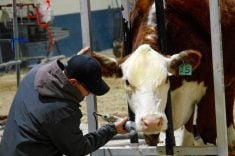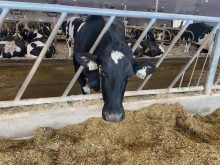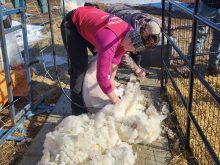Sheri Bieganski and her husband Jeff decided to add sheep to their stock farm five years ago and they’ve never looked back.
It’s been a period of remarkable growth of the sheep sector, says the Carberry-area farmer and co-owner of Shereff Stock Farms. Bieganski is also acting chair for the Manitoba Sheep Producers.
“There is a lot of optimism out there,” she said.
The latest Census of Agriculture figures on Manitoba’s sheep flock bear that out. Manitoba’s flock is the fastest growing in Canada, expanding 43.2 per cent between 2011 and 2016, to 90,423 animals in 2016. The growth is attributable to significant expansion of one producer in eastern Manitoba but overall consumer demand for fresh lamb is also spurring more entrants to the sector.
Read Also

VIDEO: Watering system a cattle health win
Portable livestock watering system helps Manitoba beef producer combat foot rot cases on pasture.
The MSA’s membership and other producers’ flock expansion also tell that story, said Bieganski.
“We’ve seen several new producers over the last few years, and at the same time existing producers have been growing their flocks as well,” she said.
Questions
But both new and existing producers also have plenty of questions around flock management and care, and the MSA’s fluctuating membership can also be seen as a sign not everyone is getting those questions answered.
The MSA recognizes that need and is trying very hard to develop and provide educational resources and opportunities for producers, said Bieganski.
“There is a steep learning curve,” she said. “There’s just so many areas in sheep production that can be stumbling blocks.”
The November 18 annual meeting was also billed as a sheep symposium, with a variety of speakers present to answer pressing questions about flock management and care.
Among them was Manitoba veterinarian Dr. Judy Hodge who spoke of some of the looming issues that producers need to recognize will affect them and how to be prepared to deal with them.
Antimicrobial resistance and increasing veterinarian oversight for antibiotics usage of them is one of them. Producers will need to ensure they have client relationships established with their veterinarians, because it will soon no longer be possible to buy medicated feed or pick up a bottle of penicillin at the local Co-op without a veterinarian’s prescription, said Hodge.
New diseases
Climate change, which can sometimes seem a distant matter, is another. What climate change is going to bring are new diseases and producers need to know the risks these diseases pose as well as what role they could inadvertently play in spreading them.
Bluetongue, which has not been detected in Manitoba yet, is spread by biting midges but as well as through contaminated needles. If bluetongue affects an animal in a flock, and the producer continues to vaccinate the flock it’s in with the same needle, the disease will be spread to other animals, she said.
“That’s going to be a risk factor once we get bluetongue,” she said. “You are going to have to start to adapt your ways of doing things.”
Hodge also stressed the importance of understanding chronic and subclinical diseases in sheep flocks. Many of the diseases that affect sheep have very long incubation periods and it will not be obvious to the producer how they’re affecting flock productivity, she said.
“It’s really just chipping away at your profits.”
The November 18 meeting also included talks from Manitoba Agriculture food safety specialist Diane Roberts on the requirements for selling at the farm gate, and Calgary-based veterinarian Dr. Michel Levy described new tests for gastrointestinal parasites.
Manitoba agriculture’s dairy specialist Rob Berry spoke about sheep nutrition and the need to pay attention to water quality. The latter can affect sheep health and productivity in ways producers may not always realize, he said.
“We wonder why animals aren’t reproducing and we may look at the feed or environment, and then we have a look at the water test,” he said.
Future vision
The MSA also released Vision 2020 — a five-point strategy at this meeting. Vision 2020 lays out five actions listed under communications, production efficiency, flock expansion, market development and organizational capacity.
A vote at this meeting to go forward with establishing an ‘enhancement board’ falls under the category of market expansion and development. The MSA’s other stated goals include increasing the number of sheep producers in the province, supporting research benefiting the sector, government lobbying to increase access to programs, and fostering economic viability within the sector through pushing the value of having lambs available year round. The MSA is also aiming to encourage new entrants into the industry and to promote lamb consumption.
















